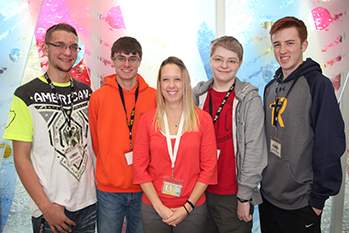
| Oct. 2015 | |||||||||||
| Top stories | |||||||||||
| In the news | |||||||||||
| Photos | |||||||||||
| Contact us | |||||||||||
| Archive | |||||||||||
|
Innovation is key in STEM classroom |
There’s good news and bad news about K-12 education in Iowa. The bad news is from Arne Duncan, the U.S. Secretary of Education (2011): “Iowa has started slowly slouching toward educational mediocrity. Student achievement isn’t declining in Iowa; instead, it’s that students in many other states and nations are rapidly improving and are now outperforming Iowa’s children. In fact, Iowa is the only state in the nation that hasn’t made significant progress in eighth-grade math since 1992.”
 Area high school students and STEM Innovators who are working with Amanda Hughes (center), environmental manager, to raise awareness about Iowa’s Ambient Air Quality program are (from left) Andrew White, Chad Thielen, Peter Hamer and Michael Sueppel.
Area high school students and STEM Innovators who are working with Amanda Hughes (center), environmental manager, to raise awareness about Iowa’s Ambient Air Quality program are (from left) Andrew White, Chad Thielen, Peter Hamer and Michael Sueppel.How did that happen?According to Duncan, Iowa was the last state in the nation to adopt standards to prepare students for college and careers, and the state has not been a leader in implementing innovation into learning.
The good news? In response to Duncan’s call to action, the Iowa Governor’s STEM Council was formed to coordinate reform efforts in STEM education. The Jacobson Institute for Youth Entrepreneurship in the Tippie College of Business and the UI College of Education created the STEM Innovator Institute, a model for engaging K-12 schools in innovation and entrepreneurship through a community-driven, problem-based, interdisciplinary approach to learning framed in a STEM context. Support for STEM Innovator came from a $250,000 grant from a new State of Iowa strategic initiative in entrepreneurship.
The State Hygienic Laboratory’s Beth Hochstedler, Education and Outreach program director, is a member of the Iowa Governor’s STEM Advisory Council. Amanda Hughes, manager of Ambient Air Quality, and Pat Blake, director of the Office of Strategic Communications, are mentors for small groups of regional high school students who are part of the STEM Innovator program.
Additional project partners include the U.S. Patent and Trademark Office, Iowa Department of Education, STEM Regional Hubs, Kirkwood Community College, Grant Wood Area Education Agency, and Iowa STEM businesses.
Two years ago, the UI College of Education surveyed 687 Iowa K-12 science, mathematics and technology teachers, and only 25% of those teachers knew what STEM was, and even fewer knew how to incorporate STEM into their teaching practice.
The STEM Innovator Institute’s creators – Dawn Bowlus and Leslie Flynn - note the definition of STEM education, as set forth by the Iowa’s Governor’s STEM Advisory Council, is more expansive than many, and it served as a catalyst for creating STEM Innovator.
In developing it, Bowlus and Flynn say they “incorporated the best evidenced-based research over the past 25 years” in cognitive science, mathematics and science education, entrepreneurship, and business education, and created a framework for teachers that focuses on developing students’ critical-thinking skills, hands-on experiences, engagement with community partners, and collaborative, problem-based learning.
“Through these activities, teachers will learn ways to engage students in STEM innovation and entrepreneurship activities, so students are engaged in authentic tasks that will resonate with them and help them see the relationships between STEM and the real world of business,” said Bowlus, director of the Jacobson Institute.
“We’re specifically making connections for students, helping them learn that what they’re studying in school ties directly into the needs of their communities and gives them the skills they need to lead our country in innovation for the next century,” said Flynn, a clinical assistant professor of science education.
This past summer, 65 rural and urban Iowa teachers—from Council Bluffs to Bettendorf—met on the UI campus to develop new ways of teaching STEM innovation and entrepreneurship. Through collaborative, interdisciplinary projects, the institute emphasizes customer discovery, opportunity recognition, rapid prototyping, and authentic interactions with STEM industry leaders. To date, over 100 Iowa teachers representing all six Iowa STEM regions have participated and are currently revising curriculum to build a community engaged in STEM entrepreneurship and innovation. An estimated 10,000 students will engage in STEM Innovator projects this school year.
One school—Manson-Northwest-Webster High School in north central Iowa—is tackling a pressing community issue: a diminishing water supply. The community has unsuccessfully attempted to dig a new well (four attempts at a cost of $1.8 million). Students work with community partners including the Iowa Department of Natural Resources, Chamber of Commerce, City Council, engineers, and geologists to locate a new water well and engage the community in water conservation until a new water source can be discovered.
“Using a train-the-trainer model during the institute, we’re confident that these teachers will also be able to share this programming in their communities, which means more teachers and community members will be involved in innovation and entrepreneurship.”
Innovation and technology are what’s driving new company formation, says David Hensley, executive director of John Pappajohn Entrepreneurial Center and UI associate vice president for Economic Development.
“In Iowa, 86 percent of companies have fewer than 20 employees, so this is a very small-business dominated state,” he says. “Students who have technology, entrepreneurship, and innovation skill sets can set their own course for whatever they’d like to do in the state of Iowa.”